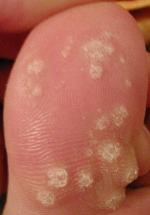
Photo from wikipedia
BACKGROUND Photodynamic therapy (PDT) has demonstrated good clinical cure rates and low recurrence rates in the treatment of genital warts. Human papillomavirus (HPV) genotypes and viral load assays can reflect… Click to show full abstract
BACKGROUND Photodynamic therapy (PDT) has demonstrated good clinical cure rates and low recurrence rates in the treatment of genital warts. Human papillomavirus (HPV) genotypes and viral load assays can reflect the status of persistent or latent infection and serve as a predictor of infection clearance. METHODS Specimens from 41 patients with HPV infection were obtained, and the HPV genotypes and viral load were analyzed using real-time polymerase chain reaction (PCR) assays. Traditional treatment, such as radiofrequency, microwave, or surgical therapy, was used to remove the visible lesions, and then PDT treatment was performed every week. HPV DNA testing was performed at every patient visit and the frequency of PDT treatment was determined by changes in HPV viral loads. RESULTS HPV viral loads decreased significantly after PDT treatment. There were significant differences in HPV viral loads between pretherapy and three or six rounds of PDT treatment. Significant differences were also observed between single and multiple type HPV infection after six rounds of PDT treatment. Patients with single type HPV infection had significantly higher rates of negative HPV DNA test results, as compared with patients with multiple infections after six rounds of PDT treatment; however, there was no difference in recurrence rates between the two groups. CONCLUSIONS Dynamic monitoring of HPV genotypes and viral loads can be used to guide PDT treatment and indicate PDT treatment efficacy in eliminating HPV.
Journal Title: Photodiagnosis and photodynamic therapy
Year Published: 2018
Link to full text (if available)
Share on Social Media: Sign Up to like & get
recommendations!